Microsoft has grudgingly agreed to let current OneDrive users keep their 15GB of free cloud storage and 15GB of free Camera Roll “bonus” storage, rather than dropping you to 5GB as previously stated, but only if you’re aware of the offer and don’t mind a bit of spam.
To take advantage of the offer, visit this Microsoft page. Microsoft representatives said the company does not have a supplementary explanatory blog post or statement to add at the present, but they did supply the webpage address, whose URL lists it as a “preview” at the moment.
You’ve already navigated the first hurdle: since users have to manually opt in to the offer, OneDrive users who are unaware of the deal won’t be able to take advantage of it. And there’s a small catch: by selecting the offer, you agree “to receive promotional emails from OneDrive,” although Microsoft immediately says that you can unsubscribe as well—how to do that, however, isn’t exactly clear.
It appears that unchecking the “promotional email” box, then clicking the “Keep your free storage” button also appears to work. In response to a question from PCWorld, a Microsoft representative said that the wording is being changed to “make it more clear”.
Why this matters: Microsoft’s reputation has climbed of late, as it’s reached out and worked with customers on the development of Windows 10, Office, and even Solitaire. But the end of unlimited OneDrive storage was a real black eye for Microsoft’s outreach efforts, and even the latest offer feels a bit half-hearted. If you want your friends to be able to take advantage of the offer, you’ll need to share it with them.
What’s going on here?
Over 60,000 different users complained about Microsoft’s changes to its OneDrive policy, which also reneged on an earlier deal to supply Office 365 subscribers with unlimited OneDrive storage at a future date. But what users were really unhappy with was Microsoft’s decision to also reduce the amount of free storage from 15GB to 5GB per account, as well as discontinuing the 15GB camera roll storage bonus for mobile users who uploaded their mobile photos to OneDrive. Microsoft’s new offer reverses the latter decision.
Microsoft has apparently maintained the 1TB limit on user accounts, however. In November, Microsoft also said that it is also doing away with the 100GB and 200GB OneDrive paid plans priced at $1.99 and $3.99 per month respectively. Instead, it will roll out 50GB of storage for $1.99 per month in early 2016. Anyone needing more storage than that can get 1TB by signing up for Office 365 Personal for $6.99 per month.
Source: www.pcworld



